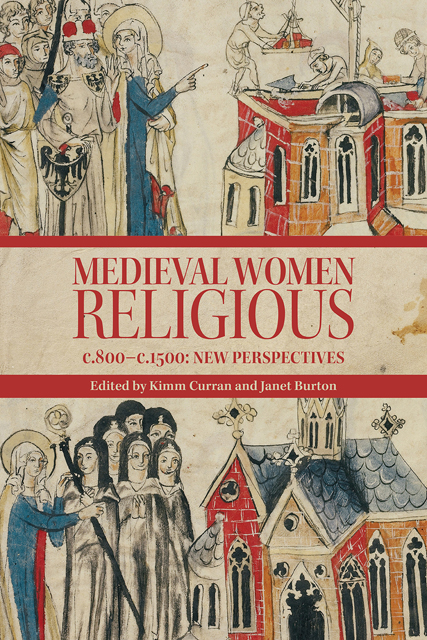Book contents
- Frontmatter
- Contents
- Illustrations
- Contributors
- Preface
- Abbreviations
- Introduction
- 1 Reform, Change, and Renewal: Women Religious in the Central Middle Ages, 800–1050
- 2 New Movements of the Twelfth Century: Diversity, Belonging, and Order(s)
- 3 Change and Renewal: Mendicants and Tertiaries in Later Medieval Europe
- 4 On the Fringes: Anchorites
- 5 ‘Quasi-religious’: Vowesses
- 6 Authority and Agency: Women as Heads of Religious Houses
- 7 Women Religious, Secular Households: The Outside World and Crossing Boundaries in the Later Middle Ages
- 8 Literacies, Learning, and Communal Reform: The Case of Alijt Bake
- 9 Family and Friends: Gift-giving, Books, and Book Inscriptions in Women’s Religious Communities
- 10 Communities of Medieval Religious Women and Their Landscapes
- 11 Materiality and Archaeology of Women Religious
- 12 Between Collective Memory and Individual Remembrance in Women’s Religious Communities
- Select Bibliography
- Index
- Miscellaneous Endmatter
7 - Women Religious, Secular Households: The Outside World and Crossing Boundaries in the Later Middle Ages
Published online by Cambridge University Press: 08 June 2023
- Frontmatter
- Contents
- Illustrations
- Contributors
- Preface
- Abbreviations
- Introduction
- 1 Reform, Change, and Renewal: Women Religious in the Central Middle Ages, 800–1050
- 2 New Movements of the Twelfth Century: Diversity, Belonging, and Order(s)
- 3 Change and Renewal: Mendicants and Tertiaries in Later Medieval Europe
- 4 On the Fringes: Anchorites
- 5 ‘Quasi-religious’: Vowesses
- 6 Authority and Agency: Women as Heads of Religious Houses
- 7 Women Religious, Secular Households: The Outside World and Crossing Boundaries in the Later Middle Ages
- 8 Literacies, Learning, and Communal Reform: The Case of Alijt Bake
- 9 Family and Friends: Gift-giving, Books, and Book Inscriptions in Women’s Religious Communities
- 10 Communities of Medieval Religious Women and Their Landscapes
- 11 Materiality and Archaeology of Women Religious
- 12 Between Collective Memory and Individual Remembrance in Women’s Religious Communities
- Select Bibliography
- Index
- Miscellaneous Endmatter
Summary
In her Treasure of the City of Ladies (1405), Christine de Pizan writes that ‘in all things the wise princess will keep her women in order just as the good and prudent abbess does her convent so that bad reports about [her household] may not circulate in the town, in distant regions or anywhere else’. In calling for the princess to configure her authority in a manner akin to the monastic superior, de Pizan promotes monastic governance as an exemplary model of household lead¬ership, thus encouraging a culture of cross-over and exchange between the court and monastic community. De Pizan’s statement is also revealing of the wider implications that women’s governance of both lay and monastic households could have on the reputation of their establishments in the world beyond their walls.
This chapter takes Christine de Pizan’s advice to the model princess as a starting point for an exploration of points of overlap, contact, and exchange between the monastic superior and her lay counterpart, specifically in relation to domestic gov¬ernance. Through a comparative analysis of the monastic superior and noblewomen who headed their own households in the Later Middle Ages, this chapter argues that there were shared cultural expectations in the ways in which women were required to articulate their domestic authority in monastic and secular contexts. Of particular interest for the discussion is the lay head of household’s exercise of spiritual leadership. As the figureheads of religious communities, the monastic superior and her lay counterpart held responsibility for the spiritual well-being of their households. Outward displays of piety, discipline, and chastity were thus essential ingredients of women’s exemplary household governance across lay and monastic settings. This chapter elucidates the ways in which the lay head of house¬hold articulated her devout domestic governance through her role models, her daily
routines, her interactions with servants, her learned piety, and through the medium of gift exchange. It argues that monastic and lay women’s performances of spiritual leadership in the monastic establishment and the noble household not only closely resembled, but also actively shaped, one another.
Connections Between Lay and Religious Women
Despite their physical enclosure, women religious had a considerable impact on the world outside the cloister in both tangible and symbolic ways. Recent schol-arship has elucidated the existence of a rich culture of contact and exchange between lay and religious women across Europe.
- Type
- Chapter
- Information
- Medieval Women Religious, c.800-c.1500New Perspectives, pp. 121 - 136Publisher: Boydell & BrewerPrint publication year: 2023

